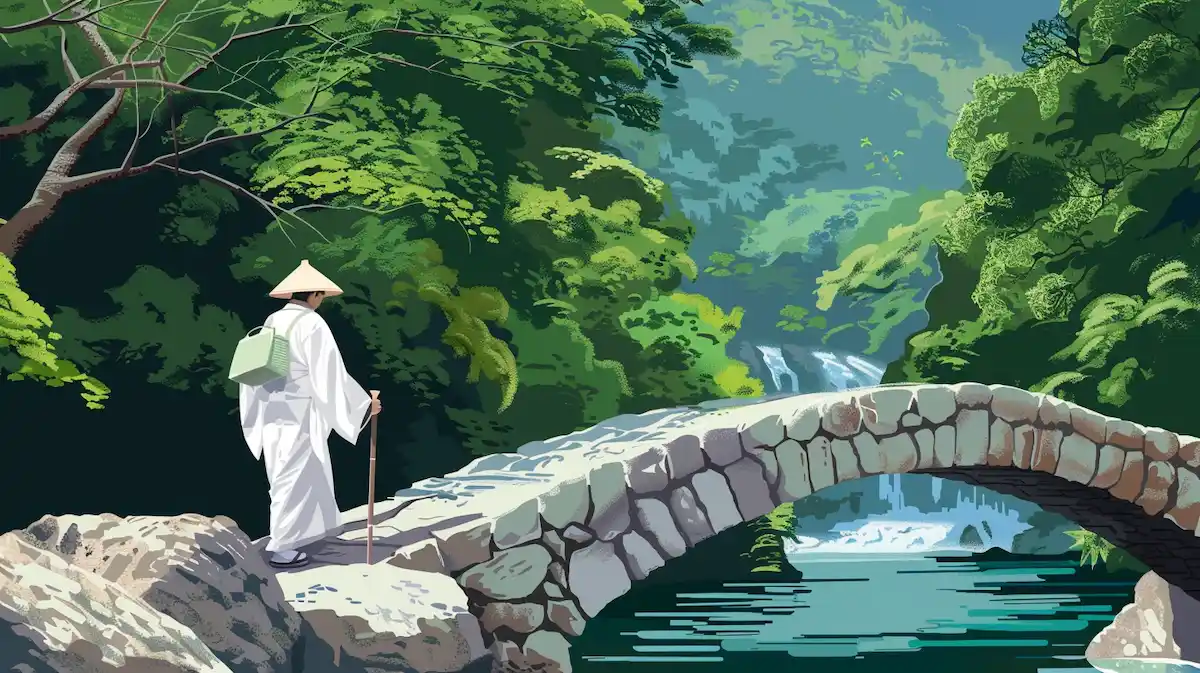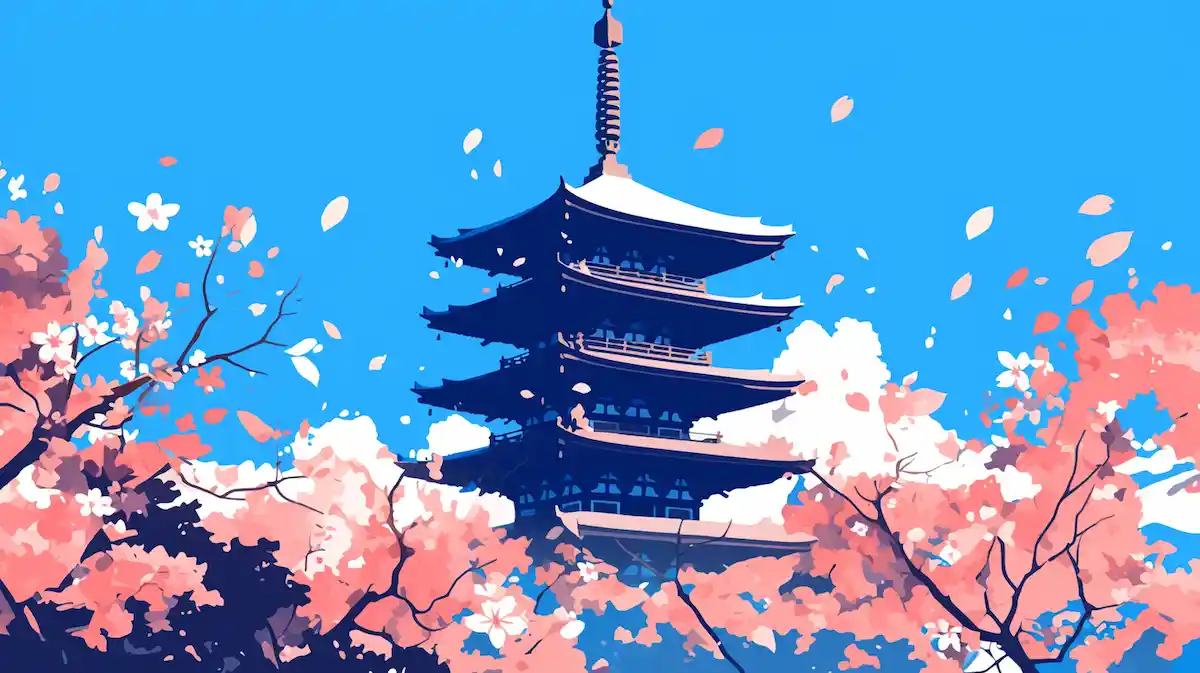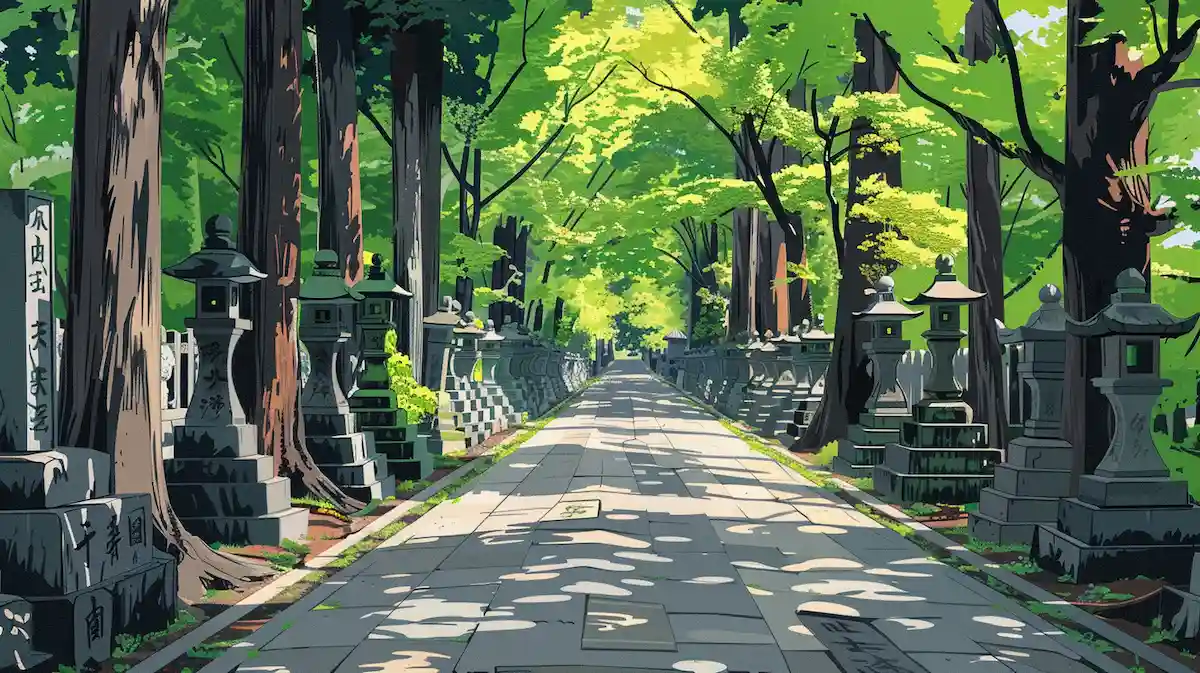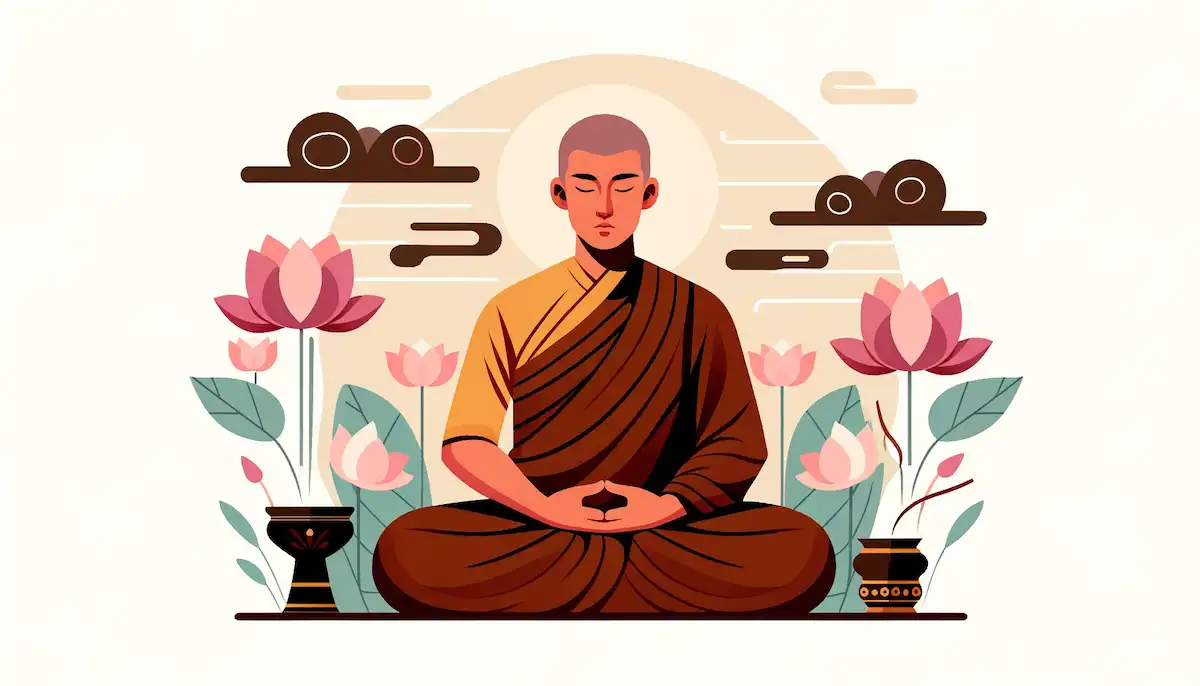空海を英語で説明・紹介するための基本情報と、英会話に役立つ表現をシンプルでわかりやすい英語で紹介します。
英会話ダイアローグ・関連情報・10の質問を通して、空海に関する英語表現を学びます。
英語
英会話ダイアローグを読む前に知っておくと良い前提知識と情報は以下の通りです。
- 空海とは
- 平安時代の僧侶で、真言宗の創設者
- 中国で密教を学び、日本に持ち帰って広めた
- 真言宗
- 密教の教えに基づく日本の仏教宗派で、空海によって創設
- 真言宗は、呪文やマントラの唱える実践が特徴
- 高野山と東寺
- 空海が創設した寺院
- 高野山の金剛峯寺は真言宗の総本山として知られ、東寺は京都にあり、多くの文化財を有している
- 嵯峨天皇と最澄との関係
- 嵯峨天皇は空海の活動を支援し、最澄は空海と同じく遣唐使として中国に渡り、天台宗を開いた僧侶
- 三筆
- 平安時代の三大書道家のことで、空海はその一人として知られている
- 他の二人は橘逸勢と嵯峨天皇
二人が、空海の生涯、業績、高野山や東寺などの関連寺院について、話しています。
また、嵯峨天皇や最澄との関係、そして空海の書道における「三筆」の一人であることも話題にしています。
彼らは高野山を訪れる計画も話しています。
会話 / dialogue

Hey Key, I’ve been really fascinated by Kūkai recently. Did you know he founded the Shingon sect?

Yes, Kūkai, or Kōbō Daishi, was quite influential. What got you interested in him?

I visited Tō-ji in Kyoto last month. The architecture and the peaceful atmosphere were breathtaking. It’s one of the temples he established.

That’s right. He also set up Kongobu-ji on Mount Koya. It’s still a key place for Shingon Buddhism. What else have you learned about him?

Well, he studied in China and brought back Esoteric Buddhism. He even stayed at Qinglong Temple in Chang’an. It’s fascinating how much he achieved after returning to Japan.

Absolutely! He was also a part of the “Three Brushes,” known for his calligraphy. I saw some of his works in a museum once—truly impressive.

Speaking of impressive, his relationship with Emperor Saga was crucial, right? I read that the emperor supported Kūkai a lot, especially in his religious endeavors.

Yes, they had mutual respect. Emperor Saga even helped Kūkai in founding several temples and promoting Buddhism. Did you know about his connection with Saichō?

A bit. They traveled to China together but studied different Buddhist teachings. Saichō founded the Tendai sect, right?

Exactly. Their journeys significantly shaped Japanese Buddhism. Have you ever thought of visiting Mount Koya to see where Kūkai spent much of his time?

I’m planning to! I want to experience the spiritual practices there, maybe even participate in some meditation sessions.

That sounds amazing. You’ll get to see where Kūkai practiced and taught his disciples. It’s also a beautiful spot for reflection.

Definitely. Learning about Kūkai’s life and achievements has given me a deeper appreciation for Japanese culture and history.

It’s incredible how figures like Kūkai have shaped so much of what we know and experience in terms of spirituality and culture.

Absolutely. Talking about this makes me want to dive even deeper into his teachings and the impact he had.

Let’s plan a trip to Mount Koya together. It would be great to explore more about Kūkai and experience the place firsthand.

Count me in! Learning and experiencing history where it happened is truly the best way to understand it.
関連情報 / related information
「空海」について、理解を深めるための「英語での関連情報」です。
空海

Early Life of Kūkai
Kūkai, also known as Kōbō Daishi, was born in 774 in Japan. He was a talented student, especially interested in Buddhism and Chinese culture. Kūkai became a monk and dedicated his life to learning and spreading Buddhist teachings.
Studies in China
In 804, Kūkai traveled to China as part of a Japanese diplomatic mission. There, he studied Esoteric Buddhism at Qinglong Temple in Chang’an, the capital of the Tang Dynasty. He learned many important Buddhist practices and teachings, which were not yet known in Japan.
Founding Shingon Buddhism
After returning to Japan, Kūkai founded the Shingon sect of Buddhism. This sect focuses on rituals, meditation, and chanting mantras. He established several temples, including the famous Kongobu-ji on Mount Koya and Tō-ji in Kyoto. These temples became centers for Shingon practices.
Contributions and Legacy
Kūkai is also famous for his contributions to Japanese culture, including art and calligraphy. He is considered one of the “Three Brushes,” celebrated for his calligraphic skills. Kūkai’s teachings and cultural contributions have had a lasting impact on Japan, and he is revered as one of the country’s most important religious figures.
10の質問 / 10 questions
「空海」について、理解を深めるための「英語での10の質問」です。
1. Who was Kūkai?
Kūkai, also known as Kōbō Daishi, was a Japanese monk from the Heian period who founded the Shingon sect of Buddhism in Japan.
2. What is Shingon Buddhism?
Shingon Buddhism is a sect of Japanese Buddhism that focuses on esoteric rituals and practices, emphasizing the use of mantras, mandalas, and rituals to achieve spiritual enlightenment.
3. What did Kūkai bring back from China?
Kūkai brought back Esoteric Buddhism teachings from China, including important texts and the practice of using mantras and mandalas.
4. Where did Kūkai study in China?
Kūkai studied at Qinglong Temple in Chang'an, which was the capital of the Tang Dynasty in China.
5. What is Kongobu-ji?
Kongobu-ji is the head temple of the Shingon sect, located on Mount Koya in Wakayama Prefecture, Japan, which was founded by Kūkai.
6. What role did Emperor Saga play in Kūkai's life?
Emperor Saga was a significant supporter of Kūkai, providing him with the resources and support to establish Shingon Buddhism and its temples.
7. What is the significance of Mount Koya in Shingon Buddhism?
Mount Koya is considered the spiritual center of Shingon Buddhism, where Kūkai founded the Kongobu-ji Temple and where he spent many years teaching and promoting Esoteric Buddhism.
8. What are the Three Brushes?
The Three Brushes refer to the three most renowned calligraphers in the Heian period, one of whom was Kūkai, celebrated for his mastery in calligraphy.
9. How did Kūkai impact Japanese culture beyond religion?
Beyond his religious influence, Kūkai greatly impacted Japanese culture through his contributions to calligraphy, literature, and the arts.
10. What is a mantra in the context of Shingon Buddhism?
In Shingon Buddhism, a mantra is a sacred phrase, word, or syllable used during meditation and rituals to embody and invoke spiritual power and enlightenment.
和訳付
会話 / dialogue

Hey Key, I’ve been really fascinated by Kūkai recently. Did you know he founded the Shingon sect?
ねえキー、最近空海にとても興味が湧いているんだ。彼が真言宗を創設したこと知ってる?

Yes, Kūkai, or Kōbō Daishi, was quite influential. What got you interested in him?
ええ、空海、またの名を弘法大師はとても影響力があったね。彼にどうして興味を持ったの?

I visited Tō-ji in Kyoto last month. The architecture and the peaceful atmosphere were breathtaking. It’s one of the temples he established.
先月、京都の東寺を訪れたんだ。その建築と平和な雰囲気が息をのむほど美しかった。彼が設立した寺の一つだよ。

That’s right. He also set up Kongobu-ji on Mount Koya. It’s still a key place for Shingon Buddhism. What else have you learned about him?
その通りだね。彼は高野山に金剛峯寺も設立したよ。今でも真言宗の重要な場所だ。他に彼について何を学んだ?

Well, he studied in China and brought back Esoteric Buddhism. He even stayed at Qinglong Temple in Chang’an. It’s fascinating how much he achieved after returning to Japan.
彼は中国で学び、密教を日本に持ち帰ったんだ。長安の青龍寺にも滞在していた。日本に帰国後に成し遂げたことの多さは本当に魅力的だよ。

Absolutely! He was also a part of the “Three Brushes,” known for his calligraphy. I saw some of his works in a museum once—truly impressive.
まったくだね!彼は「三筆」の一人としても知られていて、書道で有名だった。一度、博物館で彼の作品を見たことがあるよ—本当に感動的だった。

Speaking of impressive, his relationship with Emperor Saga was crucial, right? I read that the emperor supported Kūkai a lot, especially in his religious endeavors.
感動的なことといえば、嵯峨天皇との関係が重要だったよね?天皇が特に宗教活動において空海を大いに支援したと読んだよ。

Yes, they had mutual respect. Emperor Saga even helped Kūkai in founding several temples and promoting Buddhism. Did you know about his connection with Saichō?
ええ、彼らは互いに尊敬し合っていた。嵯峨天皇は空海がいくつかの寺を創設し、仏教を広めるのを手助けさえしたんだ。最澄との関係については知ってる?

A bit. They traveled to China together but studied different Buddhist teachings. Saichō founded the Tendai sect, right?
少し。彼らは一緒に中国へ旅行したけど、異なる仏教の教えを学んだんだ。最澄は天台宗を創設したんだよね?

Exactly. Their journeys significantly shaped Japanese Buddhism. Have you ever thought of visiting Mount Koya to see where Kūkai spent much of his time?
その通り。彼らの旅は日本の仏教に大きな影響を与えたんだ。空海が多くの時間を過ごした高野山を訪れることを考えたことはある?

I’m planning to! I want to experience the spiritual practices there, maybe even participate in some meditation sessions.
計画しているよ!そこの霊的な実践を体験したいし、瞑想のセッションに参加するかもしれない。

That sounds amazing. You’ll get to see where Kūkai practiced and taught his disciples. It’s also a beautiful spot for reflection.
それは素晴らしいね。空海が修行し、弟子たちに教えた場所を見ることができるよ。また、瞑想にぴったりの美しい場所だよ。

Definitely. Learning about Kūkai’s life and achievements has given me a deeper appreciation for Japanese culture and history.
確かに。空海の生涯と業績について学ぶことで、日本の文化や歴史をより深く理解できるようになった。

It’s incredible how figures like Kūkai have shaped so much of what we know and experience in terms of spirituality and culture.
空海のような人物が、精神性や文化において私たちが知り、経験することの多くを形作っているのは信じられないね。

Absolutely. Talking about this makes me want to dive even deeper into his teachings and the impact he had.
完全に同意だよ。これについて話すと、彼の教えや彼が与えた影響にもっと深く飛び込みたくなるね。

Let’s plan a trip to Mount Koya together. It would be great to explore more about Kūkai and experience the place firsthand.
一緒に高野山への旅行を計画しよう。空海についてもっと探求し、その場所を直接体験するのは素晴らしいことだろう。

Count me in! Learning and experiencing history where it happened is truly the best way to understand it.
参加するよ!歴史が起こった場所で学び、体験することは、それを理解する最良の方法だね。
関連情報 / related information
空海

Early Life of Kūkai
Kūkai, also known as Kōbō Daishi, was born in 774 in Japan. He was a talented student, especially interested in Buddhism and Chinese culture. Kūkai became a monk and dedicated his life to learning and spreading Buddhist teachings.
空海の初期の生活
空海、別名弘法大師は774年に日本で生まれました。彼は才能豊かな学生で、特に仏教や中国文化に興味を持っていました。空海は僧侶になり、生涯を仏教の教えの学習と普及に捧げました。
Studies in China
In 804, Kūkai traveled to China as part of a Japanese diplomatic mission. There, he studied Esoteric Buddhism at Qinglong Temple in Chang’an, the capital of the Tang Dynasty. He learned many important Buddhist practices and teachings, which were not yet known in Japan.
中国での学び
804年、空海は日本の外交使節団の一員として中国へ旅行しました。彼は唐の首都・長安にある青龍寺で密教を学びました。空海は日本ではまだ知られていない多くの重要な仏教の実践と教えを学びました。
Founding Shingon Buddhism
After returning to Japan, Kūkai founded the Shingon sect of Buddhism. This sect focuses on rituals, meditation, and chanting mantras. He established several temples, including the famous Kongobu-ji on Mount Koya and Tō-ji in Kyoto. These temples became centers for Shingon practices.
真言宗の創設
日本に帰国した後、空海は真言宗を創設しました。この宗派は儀式、瞑想、真言(マントラ)の唱えに焦点を当てています。彼は高野山の金剛峯寺や京都の東寺を含むいくつかの寺院を設立しました。これらの寺院は真言宗の実践の中心地となりました。
Contributions and Legacy
Kūkai is also famous for his contributions to Japanese culture, including art and calligraphy. He is considered one of the “Three Brushes,” celebrated for his calligraphic skills. Kūkai’s teachings and cultural contributions have had a lasting impact on Japan, and he is revered as one of the country’s most important religious figures.
貢献と遺産
空海は、芸術や書道を含む日本文化への貢献でも知られています。彼は「三筆」と呼ばれる書道の名手の一人として評価されています。空海の教えと文化への貢献は日本に長い影響を与え、彼は国内の最も重要な宗教的人物の一人として尊敬されています。
10の質問 / 10 questions
1: Who was Kūkai?
空海とは誰でしたか?
Kūkai, also known as Kōbō Daishi, was a Japanese monk from the Heian period who founded the Shingon sect of Buddhism in Japan.
空海、またの名を弘法大師とは、平安時代の日本の僧侶で、日本に真言宗を創設した人物です。
2: What is Shingon Buddhism?
真言宗とは何ですか?
Shingon Buddhism is a sect of Japanese Buddhism that focuses on esoteric rituals and practices, emphasizing the use of mantras, mandalas, and rituals to achieve spiritual enlightenment.
真言宗は、日本の仏教の宗派で、秘密の儀式や実践に焦点を当て、真言、曼荼羅、儀式の使用を強調して霊的な悟りを得ることを目指しています。
3: What did Kūkai bring back from China?
空海は中国から何を持ち帰りましたか?
Kūkai brought back Esoteric Buddhism teachings from China, including important texts and the practice of using mantras and mandalas.
空海は、重要なテキストや真言、曼荼羅の使用法を含む密教の教えを中国から持ち帰りました。
4: Where did Kūkai study in China?
空海は中国のどこで学びましたか?
Kūkai studied at Qinglong Temple in Chang'an, which was the capital of the Tang Dynasty in China.
空海は、中国唐の首都である長安の青龍寺で学びました。
5: What is Kongobu-ji?
金剛峯寺とは何ですか?
Kongobu-ji is the head temple of the Shingon sect, located on Mount Koya in Wakayama Prefecture, Japan, which was founded by Kūkai.
金剛峯寺は、和歌山県の高野山にある真言宗の総本山で、空海によって創設されました。
6: What role did Emperor Saga play in Kūkai's life?
嵯峨天皇は空海の人生でどのような役割を果たしましたか?
Emperor Saga was a significant supporter of Kūkai, providing him with the resources and support to establish Shingon Buddhism and its temples.
嵯峨天皇は空海の大きな支援者であり、真言宗とその寺院を設立するための資源と支援を提供しました。
7: What is the significance of Mount Koya in Shingon Buddhism?
高野山は真言宗にとってどのような意味がありますか?
Mount Koya is considered the spiritual center of Shingon Buddhism, where Kūkai founded the Kongobu-ji Temple and where he spent many years teaching and promoting Esoteric Buddhism.
高野山は、空海が金剛峯寺を創設し、多くの年月を密教の教えと普及に費やした場所で、真言宗の霊的中心地と考えられています。
8: What are the Three Brushes?
三筆とは何ですか?
The Three Brushes refer to the three most renowned calligraphers in the Heian period, one of whom was Kūkai, celebrated for his mastery in calligraphy.
三筆とは、平安時代に最も有名な書道家の三人を指し、その一人が書道におけるその達人として称賛される空海です。
9: How did Kūkai impact Japanese culture beyond religion?
空海は宗教以外で日本の文化にどのような影響を与えましたか?
Beyond his religious influence, Kūkai greatly impacted Japanese culture through his contributions to calligraphy, literature, and the arts.
宗教的な影響を超えて、空海は書道、文学、芸術への貢献を通じて日本の文化に大きな影響を与えました。
10: What is a mantra in the context of Shingon Buddhism?
真言宗の文脈で真言(マントラ)とは何ですか?
In Shingon Buddhism, a mantra is a sacred phrase, word, or syllable used during meditation and rituals to embody and invoke spiritual power and enlightenment.
真言宗において、真言(マントラ)は瞑想や儀式の際に使用される、霊的な力と悟りを体現し呼び起こすための神聖なフレーズ、単語、または音節です。
words & phrases
英会話ダイアローグと関連情報に出てきた単語・フレーズです(例文は各3つ)。

esoteric:形容詞
意味: 難解な、秘伝の。Intended for or likely to be understood by only a small number of people with specialized knowledge or interest.
(空海が中国で学んだ「密教」という難解で秘密の教えを指す)
例文:
The professor’s lecture on quantum mechanics was esoteric and hard for most students to grasp.
「教授の量子力学に関する講義は難解で、ほとんどの学生には理解が難しかったです。」
Esoteric Buddhism focuses on secret rituals and meditations.
「密教は秘密の儀式と瞑想に焦点を当てています。」
He has an esoteric collection of books that are rare and valuable.
「彼は珍しく貴重な本の難解なコレクションを持っています。」
endeavor:名詞
意味: 努力、試み。Serious attempts, efforts, or undertakings.
(空海が真言宗を広めるための様々な努力や活動を指す)
例文:
She’s always involved in various charitable endeavors.
「彼女は常に様々な慈善活動に関わっています。」
We appreciate your endeavors to complete the project on time.
「プロジェクトを期限内に完了させようとするあなたの努力に感謝しています。」
His scientific endeavors contributed significantly to our understanding of the disease.
「彼の科学的試みはその病気の理解に大きく寄与しました。」
disciples:名詞(複数形)
意味: 弟子たち。People who follow and learn from another person.
(空海が教えを受け継いだ弟子たちを指す)
例文:
The guru’s disciples gathered around him to learn his teachings.
「グルの弟子たちは彼から教えを学ぶために集まりました。」
He has many disciples in the academic community.
「彼には学術界に多くの弟子がいます。」
The artist trained his disciples in the traditional methods.
「その芸術家は伝統的な方法で弟子たちを訓練しました。」
teachings:名詞(複数形)
意味: 教え、教義。The ideas and principles taught by an authority.
(空海が伝えた真言宗の教えや原則を指す)
例文:
His teachings have influenced generations of philosophers.
「彼の教えは何世代にもわたる哲学者たちに影響を与えました。」
We study the teachings of various world religions in this course.
「このコースでは様々な世界宗教の教えを学びます。」
The teachings of Buddhism emphasize compassion and mindfulness.
「仏教の教えは慈悲とマインドフルネスを重視しています。」
reflection:名詞
意味: 反映、熟考。Serious thought or consideration.
(空海の教えや生涯を熟考する際の思考や考察を指す)
例文:
The book provides a reflection on the impact of technology on society.
「その本は、技術が社会に与える影響についての考察を提供しています。」
He spent hours in reflection, contemplating his next move.
「彼は次の一手を熟考するために何時間も考え込んでいました。」
The peaceful lake was perfect for quiet reflection.
「その静かな湖は静かな熟考に最適でした。」
詳細情報 / Further Info
関連記事(四国八十八ヶ所巡り、東寺(教王護国寺)、高野山)



